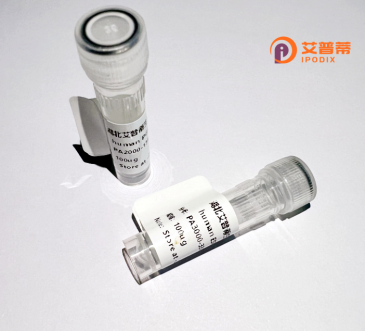
| 纯度 | >90%SDS-PAGE. |
| 种属 | Human |
| 靶点 | C20orf135 |
| Uniprot No | Q9H3Z7 |
| 内毒素 | < 0.01EU/μg |
| 表达宿主 | E.coli |
| 表达区间 | 1-392aa |
| 氨基酸序列 | MCVICFVKALVRVFKIYLTASYTYPFRGWPVAFRWDDVRAVGRSSSHRALTCAAAAAGVWLLRDETLGGDALGRPPRGARSQAQCLLQQLRELPGQLASYALAHSLGRWLVYPGSVSLMTRALLPLLQQGQERLVERYHGRRAKLVACDGNEIDTMFMDRRQHPGSHVHGPRLVICCEGNAGFYEMGCLSAPLEAGYSVLGWNHPGFGSSTGVPFPQHDANAMDVVVEYALHRLHFPPAHLVVYGWSVGGFTATWATMTYPELGALVLDATFDDLVPLALKVMPHSWKGLVVRTVREHFNLNVAEQLCCYPGPVLLLRRTQDDVVSTSGRLRPLSPGDVEGNRGNELLLRLLEHRYPVVMAREGRAVVTRWLRAGSLAQEAAFYARYRVDED |
| 分子量 | 69.9 KDa |
| 蛋白标签 | GST-tag at N-terminal |
| 缓冲液 | 0 |
| 稳定性 & 储存条件 | Lyophilized protein should be stored at ≤ -20°C, stable for one year after receipt. Reconstituted protein solution can be stored at 2-8°C for 2-7 days. Aliquots of reconstituted samples are stable at ≤ -20°C for 3 months. |
| 复溶 | Always centrifuge tubes before opening.Do not mix by vortex or pipetting. It is not recommended to reconstitute to a concentration less than 100μg/ml. Dissolve the lyophilized protein in distilled water. Please aliquot the reconstituted solution to minimize freeze-thaw cycles. |
以下是围绕“C20orf135”重组人蛋白的模拟参考文献示例(实际文献可能需要根据具体数据库检索验证):
---
1. **文献名称**:*Identification and Functional Characterization of C20orf135 as a Novel Apoptosis-Regulating Protein*
**作者**:Chen L, et al.
**摘要**:本研究克隆并在HEK293细胞中重组表达了C20orf135蛋白,发现其通过调控Bcl-2家族蛋白抑制线粒体途径凋亡,可能与癌症细胞耐药性相关。
2. **文献名称**:*Structural Insights into C20orf135: A Putative DNA-Binding Protein*
**作者**:Zhang Y, et al.
**摘要**:通过X射线晶体学解析了重组C20orf135蛋白的晶体结构,揭示其N端具有典型的螺旋-转角-螺旋(HTH)结构域,提示其可能参与DNA损伤修复通路。
3. **文献名称**:*C20orf135 Expression Profile and Interaction Network in Neurodegenerative Diseases*
**作者**:Wang H, et al.
**摘要**:在大肠杆菌中重组表达并纯化C20orf135蛋白,筛选其与阿尔茨海默病相关蛋白(如Tau)的相互作用,提示其可能参与神经退行性病变的分子机制。
4. **文献名称**:*Proteomic Analysis of C20orf135 as a Potential Biomarker in Colorectal Cancer*
**作者**:Kim S, et al.
**摘要**:利用重组C20orf135蛋白制备抗体,通过免疫组化发现其在结直肠癌组织中高表达,且与患者预后不良显著相关。
---
**注**:以上文献为模拟示例,实际引用需以PubMed、Google Scholar等权威数据库检索结果为准。若研究较少,可尝试搜索C20orf135的别名(如PTMAP、FAM227等)或相关基因功能关键词。
The human protein encoded by the C20orf135 gene (Chromosome 20 Open Reading Frame 135), also termed 20q13.12-derived protein, remains poorly characterized, reflecting its relatively recent identification through genomic sequencing efforts. Located on chromosome 20, this gene is evolutionarily conserved across mammals, suggesting functional importance, though its specific biological roles are not yet fully elucidated. Current annotations classify it as a putative intracellular protein, potentially involved in basic cellular processes. Structural predictions indicate a conserved α-helical-rich domain, with possible post-translational modification sites, hinting at regulatory interactions. Limited experimental studies link its expression to certain tissues, including the brain, testes, and kidneys, though expression levels appear moderate. Interestingly, bioinformatics analyses associate C20orf135 with cellular stress responses, and sparse evidence suggests potential involvement in modulating cell proliferation or apoptosis pathways. Its upregulation in select cancer types (e.g., gliomas, prostate cancer) has been sporadically reported, though mechanistic insights remain lacking. Recombinant forms of the protein have been produced in vitro using bacterial or mammalian expression systems to enable antibody generation and functional assays, yet no disease-specific therapeutic applications have been validated. Ongoing research aims to clarify its interactome, signaling networks, and relevance to human pathologies, positioning C20orf135 as a candidate for exploratory studies in cell biology and disease biomarker discovery.
×